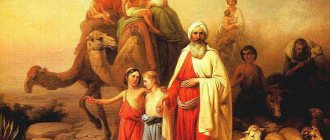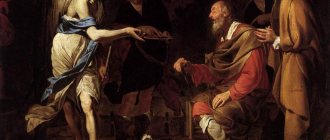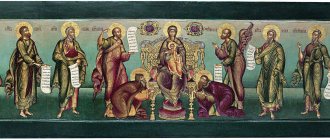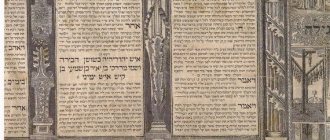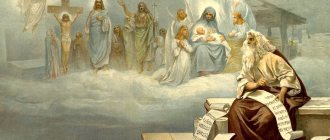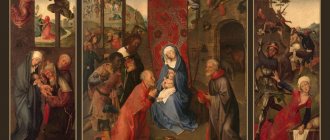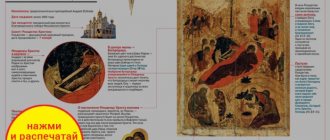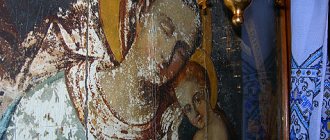The Bible, presented for family reading. Nativity of Jesus Christ
| Nativity. Modern Greek icon |
Upon Her return to Nazareth, the Virgin Mary continued to live in God-thought solitude and silence, not even informing Her betrothed Joseph about the wondrous revelations She received from the Angel.
But the Angel of the Lord himself appeared to Joseph in a dream and, saying that Mary would give birth to a Son, added: “And you will call His name Jesus, for He will save His people from their sins. And all this happened, that what was spoken by the Lord through the prophet might be fulfilled, saying, “Behold, a virgin will give birth to a Son, and they will call His name Immanuel,” which means, “God is with us.” (Matt. 1, 21–23. Isa. 7, 14). Soon the fulfillment of the inspired words of the “Old Testament evangelist” followed. The evangelists Luke and Matthew tell about this worldwide most joyful holiday, the beginning and foundation of other holy celebrations: “In those days, a command came from Caesar Augustus to make a census throughout the whole earth. And everyone went to sign up, each to his own city. Joseph also went from Galilee, from the city of Nazareth, to Judea, to the city of David, called Bethlehem, because he was from the house and family of David, to enroll with Mary, his betrothed wife.” While they were there, the time came for Christ to be born.
“And Mary gave birth to her firstborn Son, and wrapped him in swaddling clothes, and laid him in a manger, because there was no room for them in the inn. In that country there were shepherds in the field, keeping watch over their flock by night. Suddenly an Angel of the Lord appeared to them, and the glory of the Lord shone around them; and they were afraid with great fear. And the Angel said to them: Do not be afraid; I bring you good news of great joy, which will be to all people: for today a Savior has been born to you in the city of David, who is Christ the Lord; and here is a sign for you: you will find a baby wrapped in swaddling clothes, lying in a manger. And suddenly a large army of heaven appeared with the Angel, glorifying God and crying: glory to God in the highest, and on earth peace, good will towards men!
When the angels departed from them into heaven, the shepherds said to each other: let's go to Bethlehem and see what's going on.
there happened what the Lord told us about.
And they hastened and came and found Mary and Joseph, and the child lying in a manger. When they saw it, they told about what had been announced to them about this Child. And all who heard were amazed at what
the shepherds told them.
But Mary kept all these words, writing them in Her heart.
And the shepherds returned, glorifying and praising God for all that they had heard and seen, as it had been told them.” (Luke 2:1–20)
And having accepted with all their souls and filled with thoughts about the “good will in men” of the One Who Descended from Heaven, Whom they had just been called eyewitnesses, they hastened to testify to others what they had seen and heard and, thus, became the first heralds of the “good news” to the world, and from They were the first to perceive faith in the Child God, who came to save the human race.
Jesus Christ: the mystery of His name
Someone may ask: why is Christ called Jesus?..
We can find the key to understanding the mystery of His name in the words of Moses: “The Lord your God will raise up for you a prophet like me from among your brothers; Listen to Him” (Acts 7:37). However, there was a difference between Moses and the Lord Jesus (Heb. 2:5-8.). And reading Scripture we see that Moses himself, despite his greatness as a prophet and leader, did not lead the people into the Promised Land.
The successor of Moses was Joshua, through whom the Most High fulfilled his promise (Book of Joshua) - and this was a prophetic image... the Apostle Paul explained: “he still determines a certain day, “today,” speaking through David, after such a long time as It says above: “Today, if you hear His voice, do not harden your hearts.” For if Joshua [Joshua] had given them rest, no other day would have been spoken of after that. But we who have believed enter into rest…” (Heb. 4:7,8, 3). From these words we see that Joshua was a “shadow”, a prototype of Jesus Christ, leading his followers into true spiritual “rest” (compare: Ex. 23:20-23.). The Greater Joshua “Joshua” said: “Truly, truly, I say to you, I am the door of the sheep. I am the door: whoever enters through Me will be saved, and will go in and out and find pasture. My sheep obey My voice, and I know them; and they follow Me” (John 10:7,9,27).
House of Bread
In parables, the Savior sometimes talks about bread. The Lord performed two miraculous feedings of the people with nothing other than bread. The Sacrament of Communion was established by Christ through the breaking of bread. Finally, in His Lord's Prayer we call upon God to give us our daily bread.
Elsewhere in the Gospel of John, the Lord directly informs the Jews about himself: “I am the living bread that came down from heaven (John 6:51).” And this is not without reason, because “Bethlehem” is translated from Hebrew as “House of Bread” (Beit - house, lechem - bread).
The mistake of Dionysius the Less or how Christ was born later than his birth
2015 2021 2021 from the Nativity of Christ. This is how we count time all over the world today. This chronology system was proposed by the Roman abbot of Scythian origin Dionysius the Lesser in the 6th century.
Dionysius was a learned monk, and left behind many of his own works and translations of ancient authors. Among other things, he was involved in compiling and clarifying Paschal, as well as calculating the date of birth of the Savior. Pope John the First entrusted him with this work.
In his work, Abbot Dionysius was guided by the Alexandrian Paschal and biblical information that chronologically limited the date of Christ's birth. However, he did not take into account that some emperors had co-rulers, reigned under different names, etc., which is why an error crept into his calculations. They began to contradict the Holy Scriptures, which say that the Lord was born during the time of Herod the Great, although according to the calculations of Dionysius he died in the 4th year before the Nativity of Christ.
Byzantine and modern researchers, taking into account more factors, place the date of birth of the Savior at 3, 4 or 5 years before the Nativity of Christ according to the chronology of Dionysius the Less. Thus, the future Christmas may not fall in 2021, but, say, in 2021 from the real Nativity of the God-Man.
December 5 as Christmas Day first appears in the chronicle of the Christian writer of Greek origin, Sextus Julius Africanus in 221. This date coincided with the pagan celebrations of the Day of the Invincible Sun - the winter solstice.
Why do storks bring children and put a pig on the table?
One of the European Christmas legends says that a variety of animals and birds served the infant Christ in a manger. The calf warmed him with its breath, the cat calmed him with her purrs, and the dog guarded the entrance to the nativity scene. The stork also served his Lord, additionally insulating the manger of the Divine Infant with feathers from his chest.
In gratitude for this, Christ named the stork “the blessed bird and friend of all children,” giving him the honorable duty of delivering them to their parents.
In the most popular versions of the legend, the stork brings a baby rocking in a swaddle, the ends of which he holds in his beak, or in a basket attached to his back. Delivery can be directly into the hands of the mother, or into the chimney. If the future parents are sleeping, then the feathered postman can lightly pinch the mother's leg.
Storks are revered as an example of a model family. According to the same legend, these are the only birds that not only never change partners, remaining faithful to their choice all their lives, but also take care of their elderly parents, supporting them in flight and feeding them on the ground.
Another legend that takes us back to the Bethlehem manger concerns the Christmas pig. According to legend, it is eaten... as punishment for disrespect.
In “The Summer of the Lord” by the writer Ivan Shmelev, it is described as follows: “They are ordered to eat them on Christmas as a punishment! She didn’t let the baby sleep, she kept grunting. That's why it's called a pig. He wanted to stroke her, but she, a pig, pricked his hand with a bristle.”
That’s why at Christmas they serve a tender suckling pig with an apple in its teeth and parsley behind its ears.
Christmas Eve and Sochivo
Christmas Eve, the day before Christmas night, is the culmination of the pre-holiday fast and its most strict part. On Christmas Eve it is customary to completely abstain from food, which can be tasted only with the appearance of the first star.
On this evening it is customary to eat lusciously, which is why, in fact, the name “Christmas Eve” comes from. Sochivo is a special dish made from grains soaked in water and honey with nuts, as well as raisins and other fruits.
It is customary to eat in imitation of the fast of Daniel and the three youths, remembered before the feast of the Nativity of Christ, who ate from the seeds of the earth, so as not to be defiled by a pagan meal (Dan. 1, 8).
Cathedral of Christ the Savior
How is the main temple of the Russian Orthodox Church connected with the Nativity of Christ? Very simple. This temple is dedicated specifically to the Nativity of Christ and, at the same time, is a huge monument to the heroes of the Patriotic War of 1812.
After successfully expelling the enemy from the borders of our country, Emperor Alexander I ordered on this day to celebrate the deliverance of the Fatherland “from the invasion of the Gauls and with them twelve languages” - i.e. Napoleon's army, which included the French army and regiments of 12 states.
Nativity scene and nativity scene
Come to any church of the Russian Orthodox Church for Christmas. What will you see next to the temple? Right! A nativity scene symbolizing the cave where the Savior of the world was born.
In this cave there will often be a manger with a symbolic baby, as well as figures of the Mother of God, Joseph the Betrothed, shepherds and animals. It will be decorated with fir branches, garlands and a Christmas star.
This tradition has gone on for almost the third century. In the 17th century, the nativity puppet theater entered Russia from Europe, the organizers of which, in the form of a colorful performance, told children at fairs and squares about the Gospel events of the birth of the Savior, the worship of the Magi, the beating of the infants by Herod and the flight of the Holy Family to Egypt.
Later, the puppet theater was supplemented by Christmas performances organized at Christmas time by Sunday school students and nativity scenes in front of churches.
Holy days and the depravity of fortune telling
On the night of January 6-7 (if according to the secular calendar), the Church celebrates the Nativity of Christ. The two weeks from Christmas to Epiphany are called “Holy Days” or “Sviatki”.
On these days, it is customary to exchange gifts, sing Christmas spiritual hymns and especially glorify the born Christ, visiting friends and acquaintances with carols. In some areas, they organize peculiar Christmas religious processions, only with a star. When the youth church community goes from house to house with a banner in the form of the star of Bethlehem and performs small prayer services with the singing of the troparion of the Nativity of Christ.
Many Orthodox Christians dedicate Christmastide to charity, visiting sick or lonely people with songs, gifts and attention.
Some people on the holy days of the Christmas holidays resort to the help of dark forces and try to extract from them what awaits them ahead, because it is on these days that fortune telling is considered “stronger.” Fortune telling is a widespread superstition that insults holy days intended to glorify God with magical rituals.
The concept of fate is alien to a Christian—nothing but his every-minute volitional choice determines his future. This is exactly what the Church teaches us.
Christmas cards
In 1843, Sir Henry Cole sent the first ever Christmas card from London. The sketch for it was drawn by an artist familiar to Cole, John Gersley. A thousand copies were printed in total. However, Cole and Gersley did not have a thousand addressees, and the surplus edition was put on sale.
At first, the innovation was greeted coolly by society. The real boom in such postcards began only twenty years later, when printing became cheaper and the postal system was improved. Publisher Louis Prang popularized Christmas cards in 1875. He organized a nationwide competition in the United States for the best Christmas card design.
Over time, Christmas cards spread throughout the world and today each of us gives them to friends and acquaintances.
